



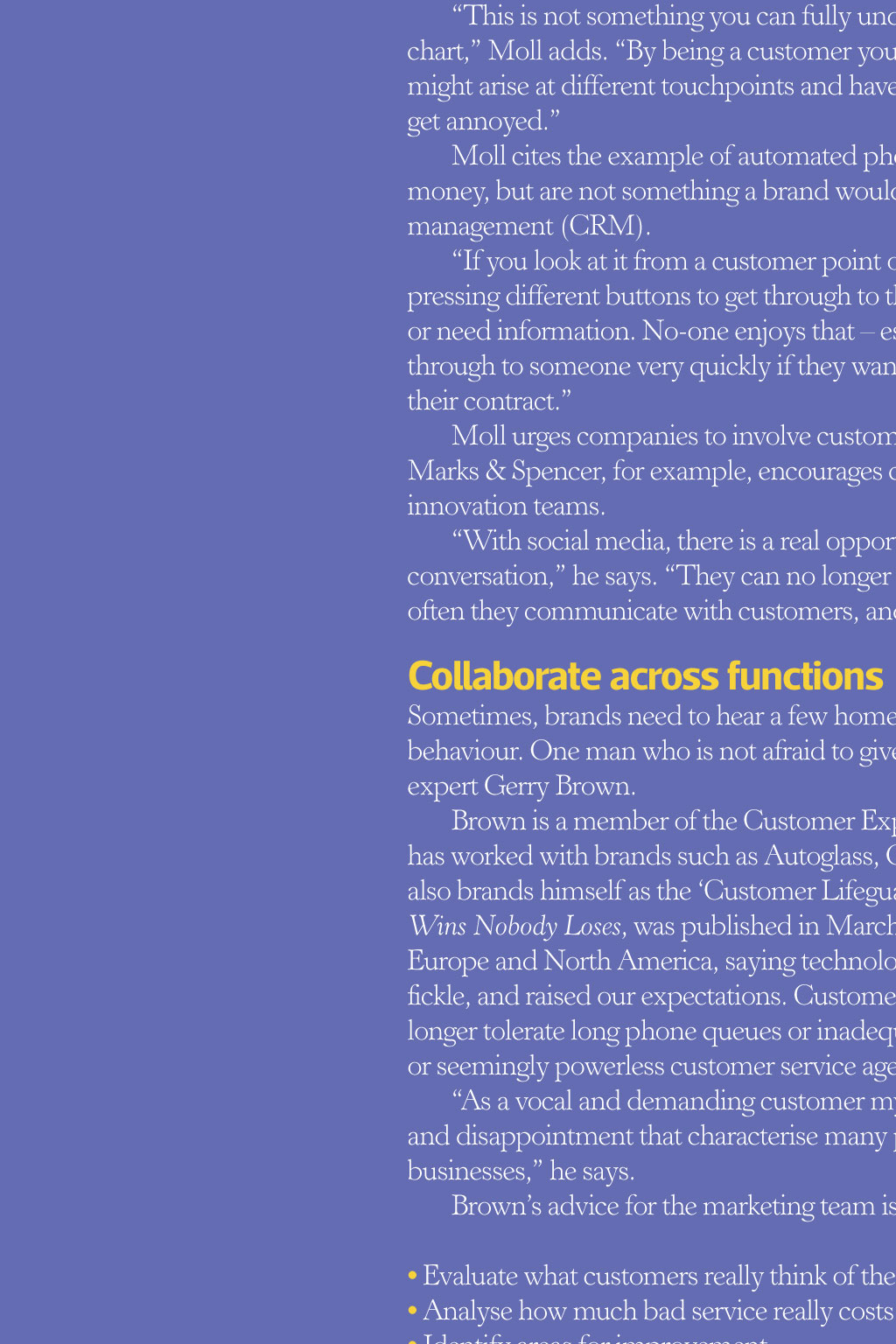
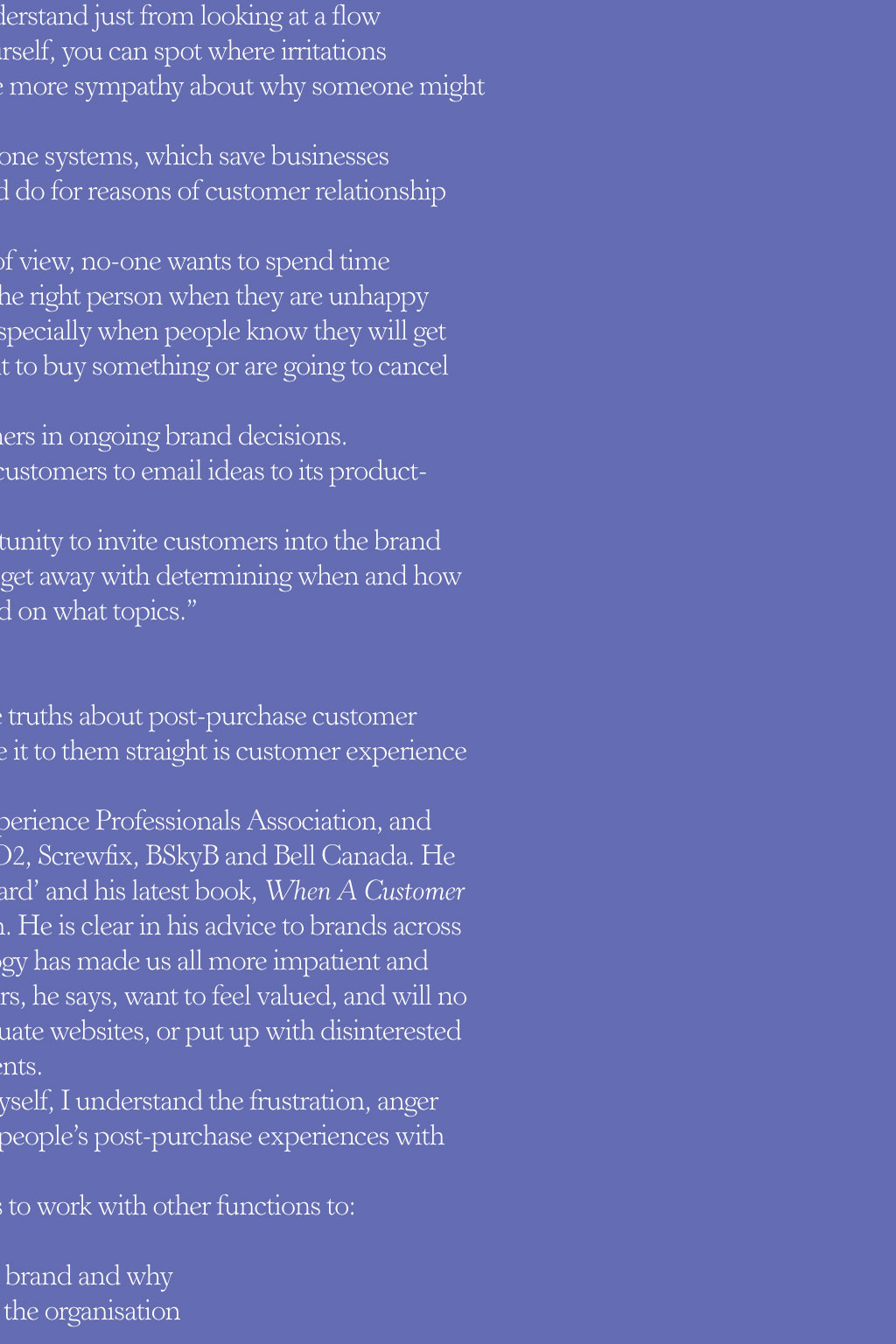
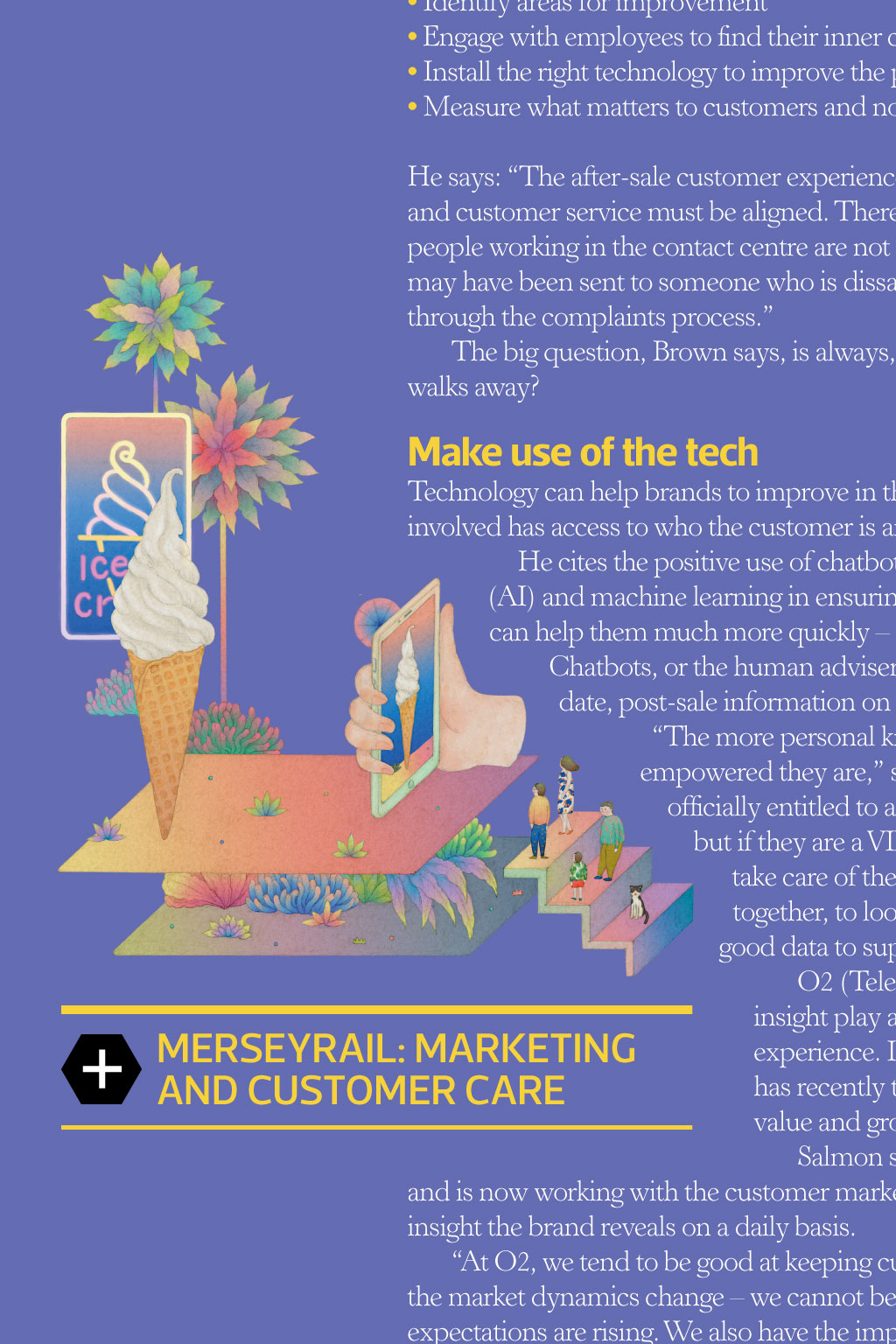

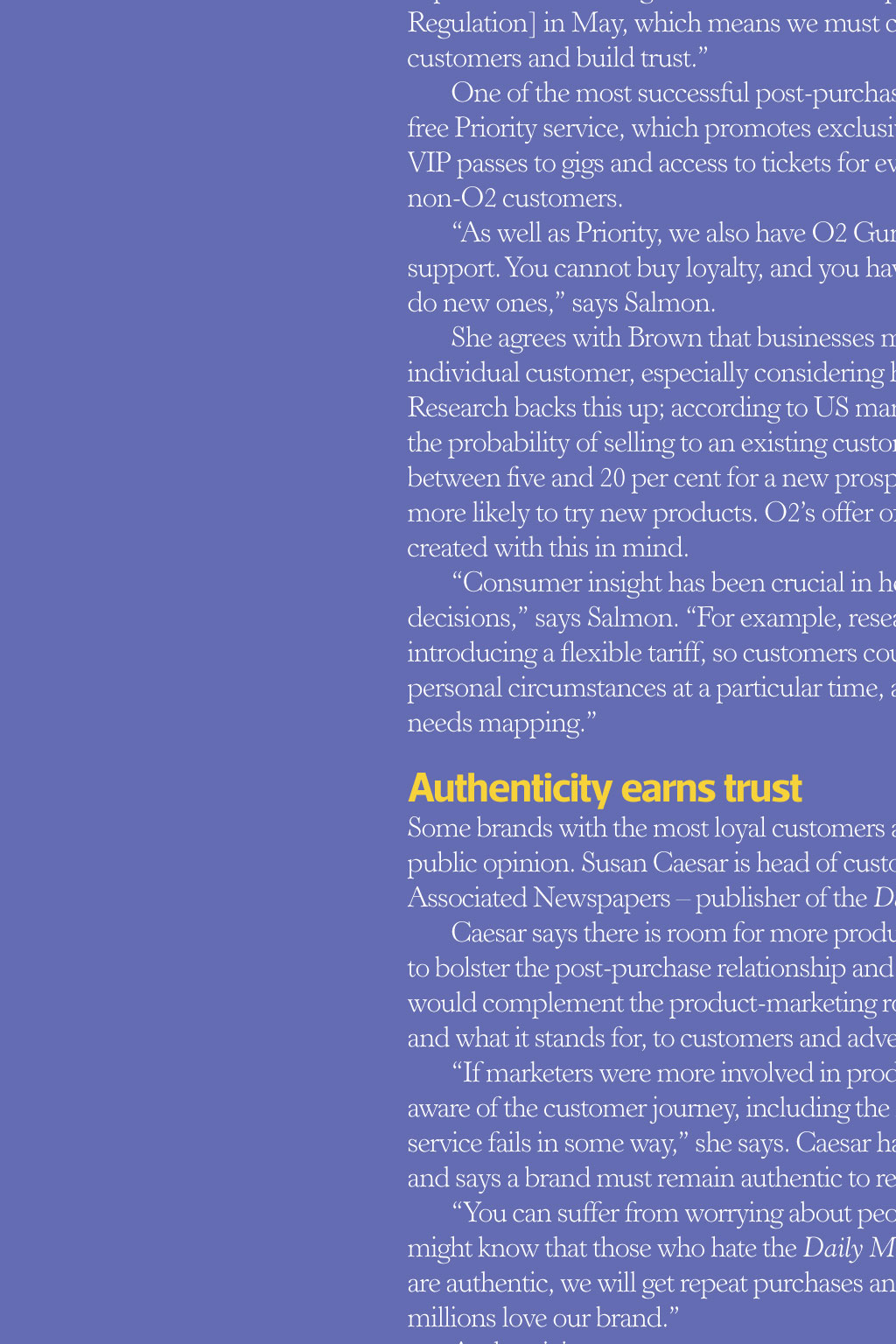

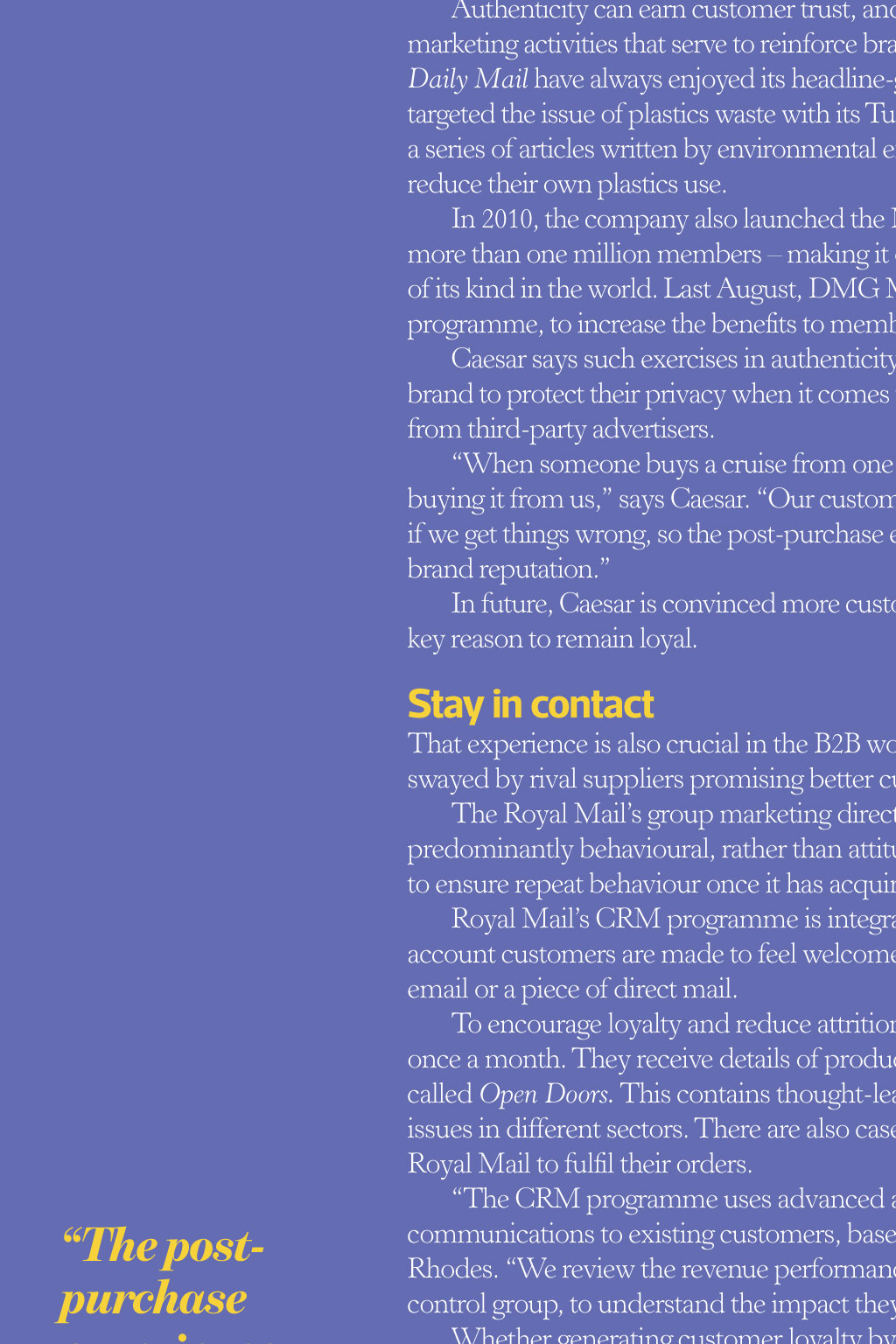
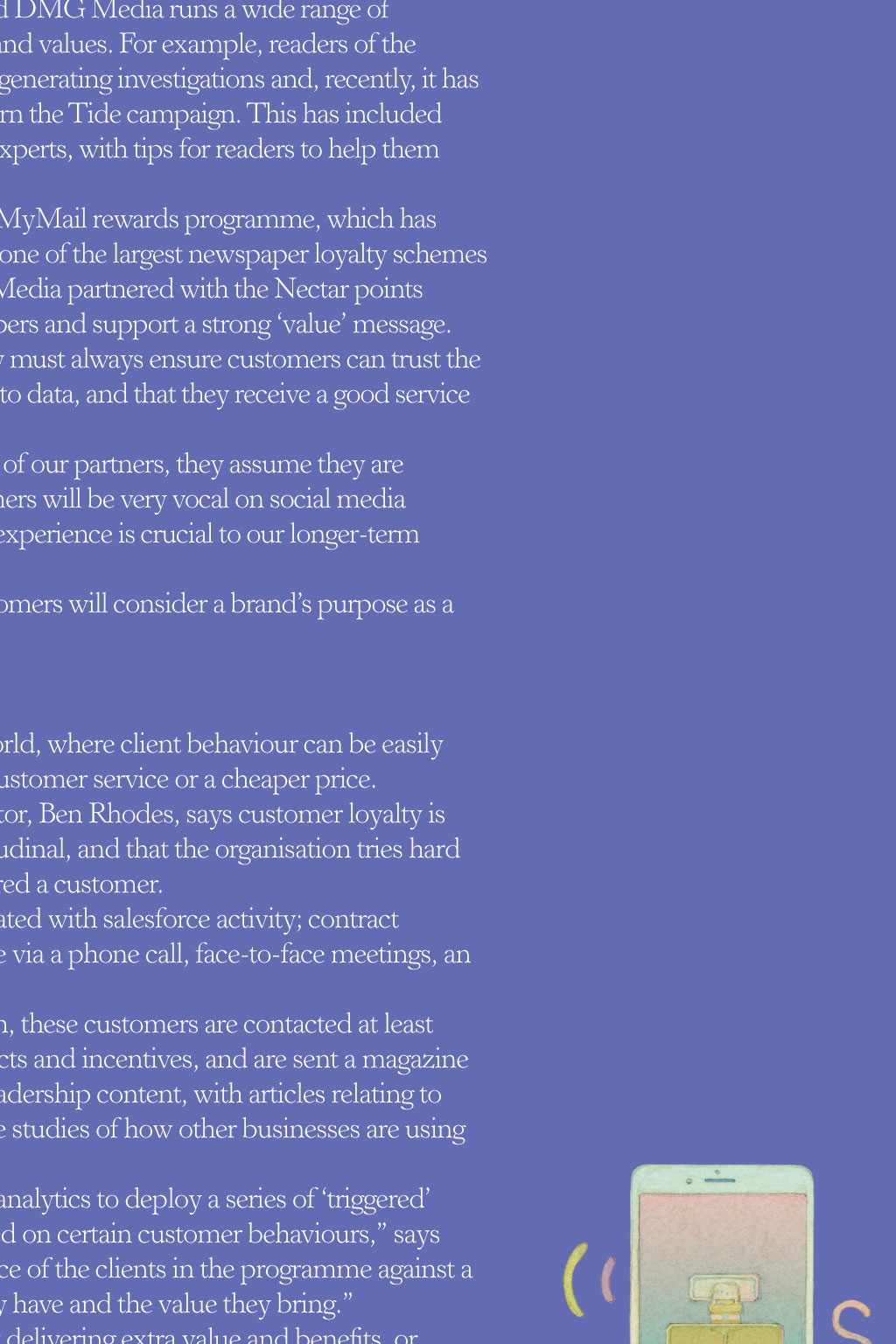

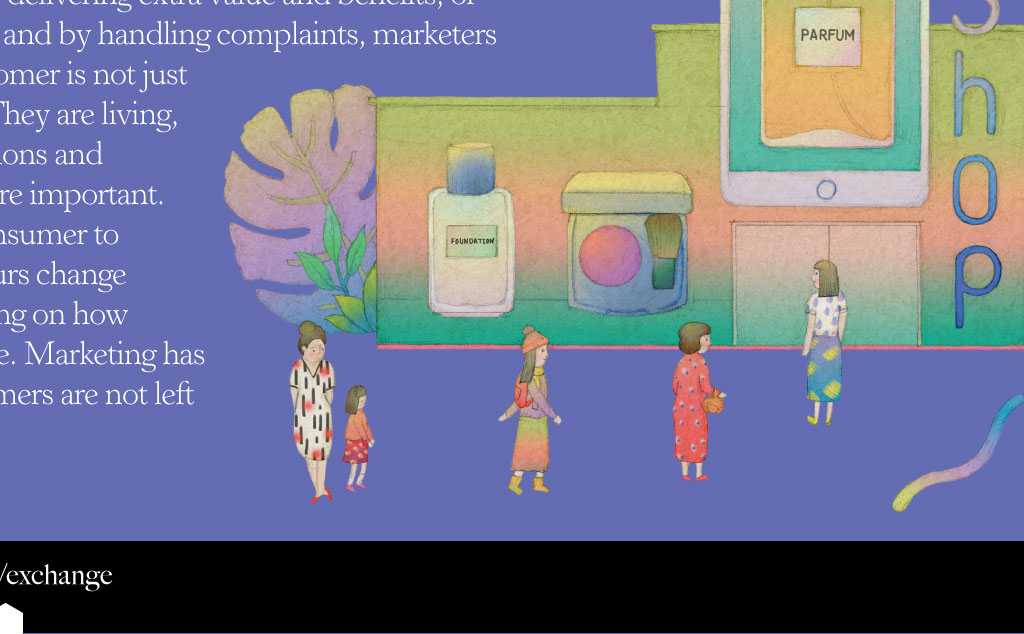















Analysis Welcome to a world beyond purchase From Amazons one-click shopping and Airbnbs reimagining of the travel industry, to the still-rising influence of social channels and concerns over privacy in the era of big data, the digital world has changed how consumers expect to interact with organisations. With it, the role of marketing has shifted too, with a renewed focus on customer experience. How can marketers draw on their unique customer insight, lead change within their organisations and ensure improved customer experience can be a central strategic pillar of business growth? Words: Steve Hemsley W hen people are no longer simply consumers to target and, instead, become customers to look after and value, their status in the eyes of brands should change. And yet, while there has been no shortage of marketing investment to boost brand awareness and acquire a sale, not enough attention has been paid to massaging the post-purchase customer relationship. That relationship is ever more vital, with social media and customer-review websites such as Trustpilot and TripAdvisor playing their part in triggering change. The right to complain, ask a difficult question, or share a frustration or disappointment is a given. Marketers are in a natural and strong position to ensure customers are treated well, post-sale, so they remain loyal and contribute lifetime value, even if the relationship is occasionally a little rocky. Proactive planning Martin Moll is a former European marketing director at Nissan Motor Corporation and now a freelance CMO. He says many brands make the mistake of waiting until things go wrong after a sale before showing that they care. They end up spending money torepair the bond with a customer who may well switch to a competitor because of theirbehaviour. When we see failures in the post-purchase journey, the remedies tend to come in the form of discounts or free product. This creates a false sense of loyalty, he says. Moll, who led a team of 26 marketers across all European markets at Nissan, believes their expertise, knowledge and insight around customer behaviour, post-purchase, should always feed into the wider business strategy. He says senior people within the brand, including marketers, should experience the after-sale journey themselves; only then can they appreciate a customers behaviour. This is not something you can fully understand just from looking at a flow chart, Moll adds. By being a customer yourself, you can spot where irritations mightariseatdifferent touchpoints and have more sympathy about why someone might get annoyed. Moll cites the example of automated phone systems, which save businesses money, but are not something a brand would do for reasons of customer relationship management (CRM). If you look at it from a customer point of view, no-one wants to spend time pressing different buttons to get through to the right person when they are unhappy or need information. No-one enjoys that especially when people know they will get throughtosomeone very quickly if they want to buy something or are going to cancel their contract. Moll urges companies to involve customers in ongoing brand decisions. Marks&Spencer, for example, encourages customers to email ideas to its productinnovation teams. With social media, there is a real opportunity to invite customers into the brand conversation, he says. They can no longer get away with determining when and how often they communicate with customers, and on what topics. Collaborate across functions Sometimes, brands need to hear a few home truths about post-purchase customer behaviour. One man who is not afraid to give it to them straight is customer experience expert Gerry Brown. Brown is a member of the Customer Experience Professionals Association, and has worked with brands such as Autoglass, O2, Screwfix, BSkyB and Bell Canada. He also brands himself as the Customer Lifeguard and his latest book, When A Customer Wins Nobody Loses, was published in March. He is clear in his advice to brands across Europe and North America, saying technology has made us all more impatient and fickle, and raised our expectations. Customers, he says, want to feel valued, and will no longer tolerate long phone queues or inadequate websites, or put up with disinterested or seemingly powerless customer service agents. As a vocal and demanding customer myself, I understand the frustration, anger and disappointment that characterise many peoples post-purchase experiences with businesses, he says. Browns advice for the marketing team is to work with other functions to: Evaluate what customers really think of the brand and why Analyse how much bad service really costs the organisation Identify areas for improvement Engage with employees to find their inner customer Install the right technology to improve the post-purchase experience Measure what matters to customers and not just to the business He says: The after-sale customer experience is everyones responsibility, but marketing and customer service must be aligned. There may be a campaign happening that the people working in the contact centre are not aware of or marketing communications may have been sent to someone who is dissatisfied with the brand and currently going through the complaints process. The big question, Brown says, is always, what value will be lost if this customer walks away? Make use of the tech Technology can help brands to improve in this area, Brown says, by ensuring everyone involved has access to who the customer is and how important they are. He cites the positive use of chatbots, and the role of artificial intelligence (AI) and machine learning in ensuring customers get through to someone who can help them much more quickly even if the phone system is automated. Chatbots, or the human adviser, must then have access to the most up-todate, post-sale information on each customer contacting the brand. The more personal knowledge a representative has, the more empowered they are, says Brown. Someone might not be officially entitled to a refund under the terms and conditions, but if they are a VIP customer who uses the brand a lot, then take care of them. Use marketing and customer service together, to look after your good customers but you need good data to support this. O2 (Telefonica UK) is a brand for which data and insight play a crucial role in improving the post-purchase experience. In fact, its head of insight, Jessica Salmon, Merseyrail: marketing has recently taken on a new role as head of customer and customer care value and growth. Salmon spent 15 years working in data and research, If the marketing team is to be responsible for the customer and is nowservices working with the customer marketing director to action the huge amount of at every touchpoint, it must include the customer insight the brand reveals on a daily basis. department. Its representatives can communicate and explain Atexperiencing O2, we tend what post-purchase barriers customers are andto be good at keeping customers for long periods, but as the market dynamics reporting feedback that can help inform marketing strategy. change we cannot be complacent, she says. Customers expectations are rising. UK regional train operator Merseyrail built understanding of We also have the impact of GDPR [the General Data Protection Regulation] May, which means we must continue to seek permission to talk to our the potential customer frustrations into a marketingin campaign customers and build trust. around the renewal of the Wirral Loop train line. The campaign One of the most successful post-purchase loyalty initiatives has been O2s won the Best Collaboration of Marketing and Customer Service free Priority service, promotes exclusive offers to customers. These include accolade, sponsored by CIM, at the European Contact Centre which and Customer Service Awards. VIPpassesto gigs and access to tickets for events at the O2 Arena, 48 hours before The challenge for Merseyrail wasnon-O2 that to redevelop the line customers. part of the route had to be closed for sixAs months welltoasreplace Priority, we also have O2 Gurus in our stores, offering customers ongoing concrete in the rail tunnels under thesupport. River Mersey. YouTravellers cannot buy loyalty, and you have to treat existing customers as well as you who had bought season or daily tickets be heavily dowould new ones, says Salmon. inconvenienced by the disruption. She agrees with Brown that businesses must appreciate the real value of each In response to expected customer complaints,customer, the company individual especially considering how expensive it is to acquire a new one. set up a dedicated social media teamResearch and postedbacks regularthis updates. up; according to US marketing optimisation consultants Invesp, Brand representatives were also at stations to give out of free ice to an existing customer is up to 70 per cent, compared with the probability selling cream to customers or hand warmers in cold weather to cheer between five and20 per cent for a new prospect. Existing customers are also 50 per cent them up while they waited for delayed connections. more likely toAn tryalternative new products. O2s offer of ongoing deals for customers has been bike bus service was also created for the busywith section created thisofinthemind. route between Birkenhead and Liverpool.Consumer insight has been crucial in helping the business to make better The campaign recognised that, while there wassays no way to decisions, Salmon. For example, research revealed how we would benefit from get around the disruption to the service, there was still a place tariff, so customers could trade up and down depending on their introducing a flexible for marketing to address customer frustrations, and keep lines of at a particular time, and as technology changes. We do a lot of personal circumstances communication open. needs mapping. Authenticity earns trust Some brands with the most loyal customers are also ones that understand they divide public opinion. Susan Caesar is head of customer service at DMG Media, formerly Associated Newspapers publisher of the Daily Mail. Caesar says there is room for more product-management expertise in marketing, to bolster the post-purchase relationship and explain a brands vision and strategy. This would complement the product-marketing role of communicating why a product exists, and what it stands for, to customers and advertisers. If marketers were more involved in product management, they would be more aware of the customer journey, including the impact on a customer, post-sale, if the service fails in some way, she says. Caesar has headed up customer care at Asos.com, and says a brand must remain authentic to retain loyalty. You can suffer from worrying about people not liking your brand, she says. We might know that those who hate the Daily Mail will never be our customers, but, if we are authentic, we will get repeat purchases and lifetime value from those who are. And millions love our brand. Authenticity can earn customer trust, and DMG Media runs a wide range of marketing activities that serve to reinforce brand values. For example, readers of the Daily Mail have always enjoyed its headline-generating investigations and, recently, it has targeted the issue of plastics waste with its Turn the Tide campaign. This has included a series of articles written by environmental experts, with tips for readers to help them reduce their own plastics use. In 2010, the company also launched the MyMail rewards programme, which has more than one million members making it one of the largest newspaper loyalty schemes of its kind in the world. Last August, DMG Media partnered with the Nectar points programme, to increase the benefits to members and support a strong value message. Caesar says such exercises in authenticity must always ensure customers can trust the brand to protect their privacy when it comes to data, and that they receive a good service from third-party advertisers. When someone buys a cruise from one of our partners, they assume they are buyingit from us, says Caesar. Our customers will be very vocal on social media ifweget things wrong, so the post-purchase experience is crucial to our longer-term brand reputation. In future, Caesar is convinced more customers will consider a brands purpose as a key reason to remain loyal. Stay in contact The postpurchase experience is crucial to our longerterm brand reputation Susan Caesar, head of customer service at DMG Media That experience is also crucial in the B2B world, where client behaviour can be easily swayed by rival suppliers promising better customer service or a cheaper price. The Royal Mails group marketing director, Ben Rhodes, says customer loyalty is predominantly behavioural, rather than attitudinal, and that the organisation tries hard to ensure repeat behaviour once it has acquired a customer. Royal Mails CRM programme is integrated with salesforce activity; contract account customers are made to feel welcome via a phone call, face-to-face meetings, an email or a piece of direct mail. To encourage loyalty and reduce attrition, these customers are contacted at least once a month. They receive details of products and incentives, and are sent a magazine called Open Doors. This contains thought-leadership content, with articles relating to issues in different sectors. There are also case studies of how other businesses are using Royal Mail to fulfil their orders. The CRMprogramme usesadvanced analytics to deploy a series of triggered communications to existing customers, based on certain customer behaviours, says Rhodes. We review the revenue performance of theclients in the programme against a control group,to understand the impact they have andthe value they bring. Whether generating customer loyalty by delivering extra value and benefits, or delivering customer care through messaging and by handling complaints, marketers must remember that the post-purchase customer is not just money in the till or an entry on a database. They are living, breathing and active beings, whose expectations and behaviours have just become a whole lot more important. When someone moves from being a consumer to a customer, those expectations and behaviours change towards a brand and they change depending on how they are treated and their ongoing experience. Marketing has a crucial role to play in ensuring those customers are not left disappointed. cim.co.uk/exchange The speed read Marketers are in a natural position to attend to customers needs post-purchase Long-term loyalty building requires more than adequate care or offering discounts Marketing must work with other departments to understand how much customers value the brand Authenticity and transparency must be placed at the centre of the post-purchase relationship Personalised and timely communications can help engender customer loyalty